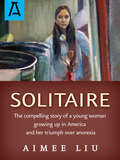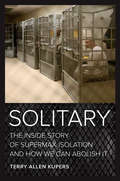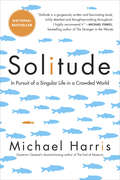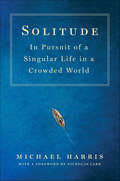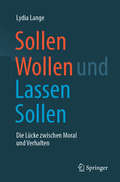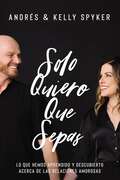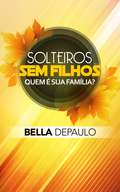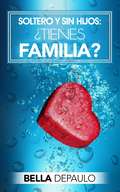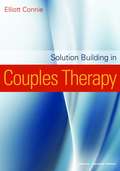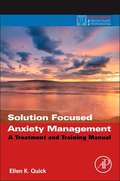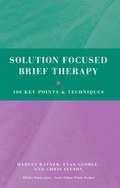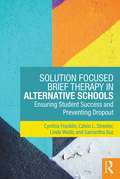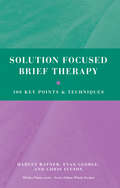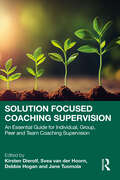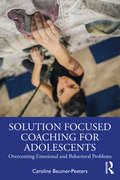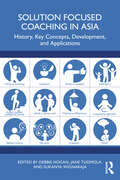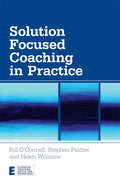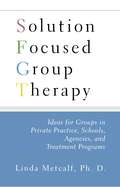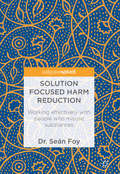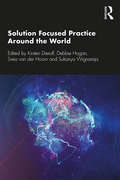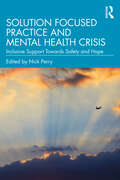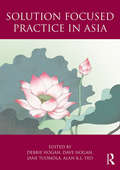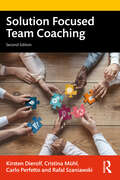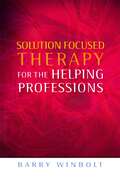- Table View
- List View
Solitaire
by Aimee LiuThe ground-breaking memoir of a young woman growing up in the 1970s and her triumph over anorexia nervosa. Aimee Liu writes honestly and forcefully about an ever-increasing problem. --American Library Association She describes in gripping detail the growing obsession with diet, calories and exercise combined with increasing alienation from family and friends. --The New York Times A harrowing tour of adolescent anxieties and loneliness...the narrative ends on a note of hope. --Publishers Weekly Brilliant and very moving...the book's insight, intelligence, and vivid prose make it highly recommended reading. --Library Journal
Solitaire
by Aimee LiuSolitaire is the groundbreaking memoir of a young woman growing up in the 1970s and her triumph over anorexia nervosa.
Solitary: The Inside Story of Supermax Isolation and How We Can Abolish It
by Terry A. Kupers“When I testify in court, I am often asked: ‘What is the damage of long-term solitary confinement?’ . . . Many prisoners emerge from prison after years in solitary with very serious psychiatric symptoms even though outwardly they may appear emotionally stable. The damage from isolation is dreadfully real.” —Terry Allen Kupers Imagine spending nearly twenty-four hours a day alone, confined to an eight-by-ten-foot windowless cell. This is the reality of approximately one hundred thousand inmates in solitary confinement in the United States today. Terry Allen Kupers, one of the nation’s foremost experts on the mental health effects of solitary confinement, tells the powerful stories of the inmates he has interviewed while investigating prison conditions during the past forty years. Touring supermax security prisons as a forensic psychiatrist, Kupers has met prisoners who have been viciously beaten or raped, subdued with immobilizing gas, or ignored in the face of urgent medical and psychiatric needs. Kupers criticizes the physical and psychological abuse of prisoners and then offers rehabilitative alternatives to supermax isolation. Solitary is a must-read for anyone interested in understanding the true damage that solitary confinement inflicts on individuals living in isolation as well as on our society as a whole.
Solitude: A Singular Life in a Crowded World
by Michael HarrisGovernor General's Award-winner Michael Harris explores the profound emotional and intellectual benefits of solitude, and how we may achieve it in our fast-paced world.The capacity to be alone--properly alone--is one of life's subtlest skills. Real solitude is a contented and productive state that garners tangible rewards: it allows us to reflect and recharge, improving our relationships with ourselves and, paradoxically, with others. Today, the zeitgeist embraces sharing like never before. Fueled by our dependence on online and social media, we have created an ecosystem of obsessive distraction that dangerously undervalues solitude. Many of us now lead lives of strangely crowded loneliness--we are ever-connected, but only shallowly so. Award-winning author Michael Harris examines why our experience of solitude has become so impoverished, and how we may grow to love it again in the frenzy of our digital landscape. Solitude is an optimistic and encouraging story about discovering true quiet inside the city, inside the crowd, inside our busy and urbane lives. Harris guides readers away from a life of ceaseless pings toward a state of measured connectivity, one that balances solitude and companionship. Rich with true stories about the life-changing power of solitude, and interwoven with reporting from the world's foremost brain researchers, psychologists and tech entrepreneurs, Solitude is a beautiful and prescriptive statement on the benefits of being alone.
Solitude: In Pursuit of a Singular Life in a Crowded World
by Michael HarrisThe author of The End of Absence shares a “gorgeously written and fascinating” inquiry into the transformative power of being alone (Michael Finkel, New York Times best-selling author of True Story).The capacity to be alone, properly alone, is one of life’s subtlest skills. Real solitude is a crucial ingredient for a rich interior life. It inspires reflection, allows creativity to flourish, and improves our relationships with ourselves and, unexpectedly, with others. Yet, in our modern world of mobile devices and social media, we have forgotten the joys of silence, and undervalued how profoundly it can revolutionize our lives.This book is about discovering stillness inside the city, inside the crowd, inside our busy lives. With wit and energy, award-winning author Michael Harris weaves captivating true stories with reporting from the world’s foremost brain researchers, psychologists, and tech entrepreneurs to guide us toward a state of measured connectivity that balances quiet and companionship.Foreword by Nicholas Carr, author of the Pulitzer Prize–finalist The Shallows.
Sollen Wollen und Lassen Sollen: Die Lücke zwischen Moral und Verhalten
by Lydia LangeDieses Buch untersucht auf evolutionspsychologischer Basis Moral und ihre Auswirkungen. Wir teilen die Welt in gut und böse ein. Moral soll sie verbessern. Da sie am Ideal ausgerichtet ist, nicht an Naturgesetzen, führt Moral häufig zu gesellschaftlich unerwünschten Nebenwirkungen. Um unsere sittlichen Ideale an das dem Menschen Mögliche anzupassen, benötigen wir neben der Moral weitere vorläufige Ergebnisse der kulturellen Evolution: gesellschaftliche Institutionen, Recht, Technik, Wissenschaft, Politik. Diese können dem Menschen dienlich sein, wenn sie die Natur des Menschen berücksichtigen.
Solo quiero que sepas: Lo que hemos aprendido y descubierto acerca de las relaciones amorosas
by Andrés Spyker Kelly SpykerEn este libro íntimo, honesto y lleno de humor, los pastores y comunicadores internacionales Andrés y Kelly Spyker comparten sobre su matrimonio de 20 años y los principios no negociables que les han ayudado a superar constantemente sus diferencias y a profundizar en su determinación de ser un equipo unido, sin dejar de fomentar los sueños y el potencial del otro.Andrés y Kelly Spyker nos entregan una obra en la que aprendemos de las relaciones de pareja, el noviazgo y toda la realidad del matrimonio, pero de una forma que va más allá de un estudio o una mera reflexión. Ellos nos llevan a través de sus propias vivencias personales y nos muestran cómo el Señor los guio en medio de las incertidumbres y complejidades propias de la juventud para poder tener un noviazgo y luego un matrimonio fructífero, sabio, duradero y que da gloria a Dios.En Solo quiero que sepas, los Spyker abordan cuestiones y responden a preguntas sobre:La elección de la parejaLos principios del noviazgoLa presión de los primeros años de matrimonioResolución de conflictos y acuerdosPor qué el mejor sexo se da en el matrimonioEl secreto de estar casado y ser feliz, y mucho másSolo quiero que sepas ayudará a muchos a recorrer con mayor sabiduría el territorio escarpado que Andrés y Kelly ya recorrieron con éxito y que ahora ponen en nuestras manos de manera honesta, coloquial, amena y llena de enseñanzas de principio a fin.I Just Want You to KnowIn this intimate, honest, and humorous book, pastors and international communicators Andres and Kelly Spyker share on their 20-year marriage and the non-negotiable principles that have helped them to consistently overcome their differences and deepen their resolve to be a unified team, while still fostering each other&’s dreams and potential.Andres and Kelly Spyker present us with a book in which we learn about relationships, courtship and the reality of marriage, but in a way that goes beyond a study or a mere reflection. They take us through their own personal experiences and show us how the Lord guided them in the midst of the uncertainties and complexities of youth to be able to have a courtship and then a fruitful, wise, lasting marriage that gives glory to God.In I Just Want You to Know, the Spykers address issues and answer questions about:Choosing a mateThe principles of courtshipThe pressures of the early years of marriageConflict resolution and compromiseWhy the best sex happens in marriageThe secret to being married and being happy, and much moreI just want you to know will help many to walk more wisely through the rugged territory that Andres and Kelly have already successfully traversed and now put in our hands in an honest, colloquial, entertaining and teaching-filled way from beginning to end.
Solteiros, sem filhos: quem é sua família?
by Bella Depaulo Mariana Eunice Alves de AlmeidaEnquanto muitos costumam descriminar pessoas solteiras, sem filhos, como aqueles que não têm nenhuma família, a renomada especialista em solteiros, Professora DePaulo vai na contramão. Ao invés de repudiá-los, ela nos fornece um exemplo eficaz do importante papel que pessoas solteiras têm ao manter as famílias unidas, ao criar novas formas de famílias, e ao propor formas inovadoras de se viver. Este breve livro inclui novos escritos e artigos previamente publicados em revistas como a Time. Ele divide-se em quatro capítulos. 1. Bem-vindo a formas mais amplas e gerais de se pensar sobre famílias 2. Como nossas famílias tornaram-se muito mais do que apenas mãe, pai e os filhos 3. Famílias e modos de vida inovadores 4. Por que as pessoas se irritam com mulheres que permanecem solteiras e não têm filhos? 5. Solteiros, sem filhos: quem é sua família?
Soltero y sin hijos: ¿Tienes familia?
by Bella Depaulo Marisoly Álvarez ScarpittaEste reciente libro de la renombrada experta Bella DePaulo incluye nuevos escritos así como artículos anteriormente publicados en la revista Time, Quartz y una publicación académica: 1. Bienvenidos a maneras más amplias e inclusivas de pensar sobre la familia 2. Cómo nuestras familias llegaron a ser más que Mamá, Papá y los niños 3. Familias innovadoras y Maneras innovadoras de vivir 4. ¿Por qué la gente se enoja con las mujeres que deciden no casarse y tampoco tienen hijos? 5. Soltero y sin hijos: ¿Tienes familia? Mientras que muchos pueden sentirse tentados a desdeñar a las personas solteras y sin hijos pensando que no tienen familia, la Profesora DePaulo ha estado siempre a la defensa de los solteros; y, en lugar de ello, provee poderosa evidencia en favor del papel extraordinario que cumplen las personas solteras en mantener a las familias unidas, creando nuevos tipos de familia y creando formas innovadoras de vivir.
Solution Building in Couples Therapy
by Elliott ConnieAt the core of this step-by-step guide to solution focused therapy is a real-life evolving case study, offering readers a highly detailed panorama of couples therapy in action. Beginning with a clear explanation of the assumptions and tenets required for the practice of solution focused therapy, the book presents a step-by-step breakdown of exactly how to conduct solution-focused sessions with couples. Each chapter highlights a different part of the therapeutic process and includes sample dialogues, techniques, vignettes from the evolving case example, and thought-provoking questions. Readers will feel as though they themselves are going through the therapeutic process with the couple and observing the impact of each step of the process.
Solution Focused Anxiety Management: A Treatment And Training Manual
by Ellen K. QuickSolution Focused Anxiety Management provides the clinician with evidence-based techniques to help clients manage anxiety. Cognitive behavioral and strategic tools, acceptance-based ideas, and mindfulness are introduced from a solution-focused perspective and tailored to client strengths and preferences. The book presents the conceptual foundation, methods, and attitudes of a solution-focused approach. Case examples illustrate how to transform anxiety into the "Four Cs" (courage, coping, appropriate caution and choice). Readers learn how to utilize solution focused anxiety management in single-session, brief, and intermittent therapy as well as in a class setting. The book additionally includes all materials needed for teaching solution focused anxiety management in a four-session psychoeducational class: complete instructor notes, learner readings, and companion online materials. Special Features: Focuses on what works in anxiety management Presents evidenced based techniques from a solution-focused perspective Increases effectiveness by utilizing client strengths and preferences Describes applications in single session, brief, and intermittent therapy Supplies forms and worksheets for the therapist to use in practice Features clinically rich case examples Supplements text with online companion material Suitable for use as a treatment manual, reference, or course text Offers a solution-focused anxiety treatment Focuses on anxiety management, not "elimination" Translates the program to individual therapy Presents patient exercises and case examples Includes a guide for teaching/learning this therapeutic technique
Solution Focused Brief Therapy
by Evan George Harvey Ratner Chris IvesonSolution Focused Brief Therapy: 100 Key Points and Techniques provides a concise and jargon-free guide to the thinking and practice of this exciting approach, which enables people to make changes in their lives quickly and effectively. It covers: The history and background to solution focused practice The philosophical underpinnings of the approach Techniques and practices Specific applications to work with children and adolescents, (including school-based work) families, and adults How to deal with difficult situations Organisational applications including supervision, coaching and leadership. Frequently asked questions This book is an invaluable resource for all therapists and counsellors, whether in training or practice. It will also be essential for any professional whose job it is to help people make changes in their lives, and will therefore be of interest to social workers, probation officers, psychiatric staff, doctors, and teachers, as well as those working in organisations as coaches and managers.
Solution Focused Brief Therapy in Alternative Schools: Ensuring Student Success and Preventing Dropout
by Calvin L. Streeter Cynthia Franklin Linda Webb Samantha GuzSolution Focused Brief Therapy in Alternative Schools (SFBT) provides a step-by-step guide for how school social workers and counselors can work with other school professionals to create an effective solution focused dropout prevention program. Along with illustrative cases and detailed explanations, the authors detail the curriculum and day-to-day operations of a solution focused dropout prevention program by drawing on the experiences of a school that uses this approach.
Solution Focused Brief Therapy: 100 Key Points and Techniques (100 Key Points)
by Evan George Harvey Ratner Chris IvesonSolution Focused Brief Therapy: 100 Key Points and Techniques provides a concise and jargon-free guide to the thinking and practice of this exciting approach, which enables people to make changes in their lives quickly and effectively. It covers: The history and background to solution focused practice The philosophical underpinnings of the approach Techniques and practices Specific applications to work with children and adolescents, (including school-based work) families, and adults How to deal with difficult situations Organisational applications including supervision, coaching and leadership. Frequently asked questions This book is an invaluable resource for all therapists and counsellors, whether in training or practice. It will also be essential for any professional whose job it is to help people make changes in their lives, and will therefore be of interest to social workers, probation officers, psychiatric staff, doctors, and teachers, as well as those working in organisations as coaches and managers.
Solution Focused Coaching Supervision: An Essential Guide for Individual, Group, Peer and Team Coaching Supervision
by Kirsten Dierolf Debbie Hogan Jane Tuomola Hoorn, Svea van derSolution Focused Coaching Supervision offers the reader a theoretically coherent framework for coaching supervision, outlined in an engaging way that is simple to understand and apply immediately using a variety of collaborative coaching supervision moves grounded in practical examples. The book offers an in depth understanding of the theory of Solution Focused Supervision, which as a social-constructionist approach, privileges the coaching supervision clients’ experience, resources and preferred future over an “analytic” or deficit-oriented stance. It also provides a step-by-step “how-to” for individual, group, peer and team coaching supervision. Coaching supervision ethics is discussed in theory and via real case examples. Deliberate and reflective practice models will enable readers to develop their practice wherever their starting point may be. The reader will also find transcripts of actual coaching supervision sessions to bring the theory to life. An essential and comprehensive resource that will enable beginner coaching supervisors to start practising this highly respectful and ethical approach to coaching supervision, while also inspiring more advanced coaching supervisors to use this simple and effective approach to coaching supervision.
Solution Focused Coaching for Adolescents: Overcoming Emotional and Behavioral Problems
by Caroline Beumer-PeetersSolution Focused Coaching for Adolescents explains the principles and attitude of the popular 11-step, Mission Possible, Solution Focused Coaching program for working with adolescents. By comparing the Mission Possible principles with the 'normal' way of problem-solving in coaching scenarios, the author makes the theoretical structure and conversational style of the program easy to learn for professionals. Applied both individually and as a group activity, Mission Possible is a learning experience that makes fulfilling dreams and achieving goals easier for teenagers and young adults. It helps to make difficult things accessible for them by using one's own strengths and resources. The book is filled with detailed case studies and useful coaching tools, breaking the program down into five themes, outlining the goals, the process, and any potential pitfalls. This practical book is intended for coaches, youth counselors, trainers, teachers, mentors, and therapists who want to coach young people using the clear step-by-step Mission Possible-program, and all those working in pastoral roles with children and adolescents.
Solution Focused Coaching in Asia: History, Key Concepts, Development, and Applications
by Debbie Hogan Jane Tuomola Sukanya WignarajaThrough inspiring stories illustrating the diverse application of coaching within Asian contexts, this data-rich volume dives into the theory and practice of Solution Focused coaching offering numerous tools and techniques that can be used immediately. With the rising demand for coaching across Asia, there is a need for coaches to have access to up-to-date practice-based evidence of its effectiveness. The Solution Focused approach, as a social-constructionist approach, privileges the clients’ experience, resources, and preferred future over an 'analytic' or deficit-oriented stance. Contributors analyse real case examples from many countries across Asia including Singapore, Malaysia, Indonesia, China, Taiwan, Hong Kong, Japan, Cambodia, and Sri Lanka. Practical in its approach, the book offers new insights into established areas of coaching and also highlights innovations in coaching in areas where Solution Focused coaching and other models have not reached until recently. These areas include health and wellness coaching for medical compliance needs, faith-based coaching, and coaching incarcerated fathers.This is an essential and comprehensive resource that is written for both beginner and experienced coaches and addresses the need for effective and culturally sensitive coaching models in Asia. It will also be beneficial for managers and health care professionals looking to enhance their work through coaching skills.
Solution Focused Coaching in Practice (Essential Coaching Skills and Knowledge)
by Stephen Palmer Helen Williams Bill O'ConnellSolution Focused Coaching in Practice is a practical 'how-to' guide that provides an invaluable overview of Solution Focused Coaching skills and techniques. Reflecting upon published research on the solution focused approach, Bill O'Connell, Stephen Palmer and Helen Williams bring their own experiences of Solution Focused Coaching together with others in the field to cover topics such as: the coach-coachee relationship the role of technology in coaching inclusive coaching group and team coaching practical issues and skills. Incorporating coachee case studies, worksheets, practice tips and discussion points, the skills, strategies and techniques in this book are straightforward to apply and can be used in most coaching settings. This practical book is essential reading for experienced personal or executive coaches, managers considering introducing a new and better coaching culture for their staff, and for those just starting out on their coaching journey.
Solution Focused Group Therapy: Ideas for Groups in Private Practice, Schools and Treatment Programs
by Linda MetcalfIn this book, Linda Metcalf persuasively argues that the collaborative nature of group therapy actually lends itself to time-limited treatment. She combines the best elements of group work and the popular solution focused brief therapy approach to create new opportunities for practitioners and patients alike. Among the topics covered in this valuable guide are: how to learn the model; how to design a group and recruit members; how to identify exceptions to a group member's self-destructive behaviors and thoughts; how to help members focus on their successes rather than their failures; how to keep the group solution focused when therapists or members fall back into old patterns.
Solution Focused Harm Reduction: Working effectively with people who misuse substances
by Seán FoyThis is the first book to explain the many synergies between solution focused brief therapy (SFBT) and harm reduction (HR). Seán Foy discusses how these two approaches are complementary and when used in conjunction, create a novel way of approaching addiction work. The book covers several detailed case studies examining how the concepts and theories of both approaches are intertwined to enhance and deepen the work undertaken with people who misuse and abuse substances. It will be of great interest to scholars of psychotherapy, social work, social care, addiction, nursing and health care, as well as to practitioners seeking a clearer understanding of solution focused brief therapy and harm reduction and how to apply these to case work with problematic drinkers and drug users.
Solution Focused Practice Around the World
by Kirsten DierolfSolution Focused Practice Around the World provides an exploration of the diverse uses of SF and offers fascinating insights into how the Solution Focused approach is currently used in many applications around the globe. Bringing together prominent authors, practitioners and trainers, the collection is divided into five sections: theory; therapeutic applications; working with children and adolescents; coaching and working with organisations. Originating from the first international conference on Solution Focused practice spanning all applications of the approach, the chapters provide a grounding in the theory and practice, and an exploration of the breadth and depth of Solution Focused therapy. All practitioners of the Solution Focused approach globally as well as those working in the wider fields of therapy, social work, education, coaching and human resources will benefit from this text and the applicability of the inherent theories to their area of expertise.
Solution Focused Practice and Mental Health Crisis: Inclusive Support Towards Safety and Hope
by Nick PerryThis book provides an interdisciplinary understanding of Solution Focused Practice (SFP) and how to use the approach when working with people in mental health crisis.The book takes a whole systems perspective, presenting SFP as a "common language" between different professional cultures and making the case for its use across all environments of mental health crisis care. The chapters explore the uniqueness of SFP, chart its history in the UK, and outline ways in which SFP can optimise client agency as well as positively impact worker wellbeing. Anonymised accounts of professional experiences are included throughout to give readers an understanding of how Solution Focused questions can change the balance of power within practice situations and provide inclusive support towards safety and hope.This will assist a wide range of professionals involved in and working alongside the mental health system including psychiatrists, nurses, social workers, psychologists, therapists, counsellors, and other support staff. We hope it will also be useful for service users.
Solution Focused Practice in Asia
by Debbie Hogan Dave Hogan Jane Tuomola Alan K. YeoThis book is a collection of solution focused practice across Asia, offering case examples from the fields of therapy, supervision, education, coaching and organisation consulting. It demonstrates the usefulness of the solution focused approach in the Asian context by providing practice based evidence, and highlights the diversity of application. By sharing real case examples in action across Asia, it is the aim of this book to stimulate the curious and inspire the converted. It gives readers a taste of what it is like to use this approach within an Asian context, in different areas of practice and within a broad spectrum of clinical issues. The examples offer exciting and creative ways in which solution focused practice can be used within the Asian context – with the hope that more practitioners will be curious enough to give solution focused practice serious consideration as a viable, evidence-based practice.
Solution Focused Team Coaching
by Kirsten Dierolf Cristina Mühl Carlo Perfetto Rafal SzaniawskiSolution Focused Team Coaching offers readers a simple, practical and effective way to coach teams. Its evidence-based approach, which has been applied successfully to many fields, is presented in an engaging, pragmatic and approachable way, making this book a must read for anyone who wants to broaden their horizon within the team coaching space. This book presents the background and philosophy of Solution Focused team coaching and then moves on to explore its practical application in various formats of team coaching, with different audience dimensions. The reader will find a useful structure for team coaching processes as well as detailed descriptions for facilitating team coaching “moves” (conventionally called “techniques” or “tools”) for both online and live settings. With this book, it is easy to plan a Solution Focused team coaching process from contract negotiation through workshop design to follow-up and evaluation. It covers difficult team situations such as conflicts, and different forms of teams from shop-floor to executive teams, Agile teams and special formats of team coaching, as well as how to facilitate larger teams. Additionally, readers who want to achieve certification and/or accreditation will find it extremely useful to read about ICF, EMCC and AC team coaching competencies and how Solution Focused team coaching is an easy way of embedding those competencies. Solution Focused Team Coaching is a must for any coach, from those who would like to learn a pragmatic, impactful and easy way to move into team coaching to experienced team coaches who would like to learn a new approach and expand their skills, and anybody interested in exploring the fascinating world of team coaching.
Solution Focused Therapy for the Helping Professions
by Barry WinboltThis accessible guide to Solution Focused Brief Therapy (SFBT), an effective therapeutic approach which focuses on strengths and achievements, provides a practical introduction to what SFBT is and how to use it with clients. Barry Winbolt leads the reader through the principles, techniques and steps involved in the approach, including forming a productive working relationship with the client, using questions creatively, the effective use of language, and working collaboratively with the client in finding solutions. Case studies are included to demonstrate the ideas and techniques presented. This book will be invaluable to all those in the helping professions who are either already familiar with SFBT and want to improve their knowledge, or are looking for new and effective ways to communicate with and help the people they work with.
